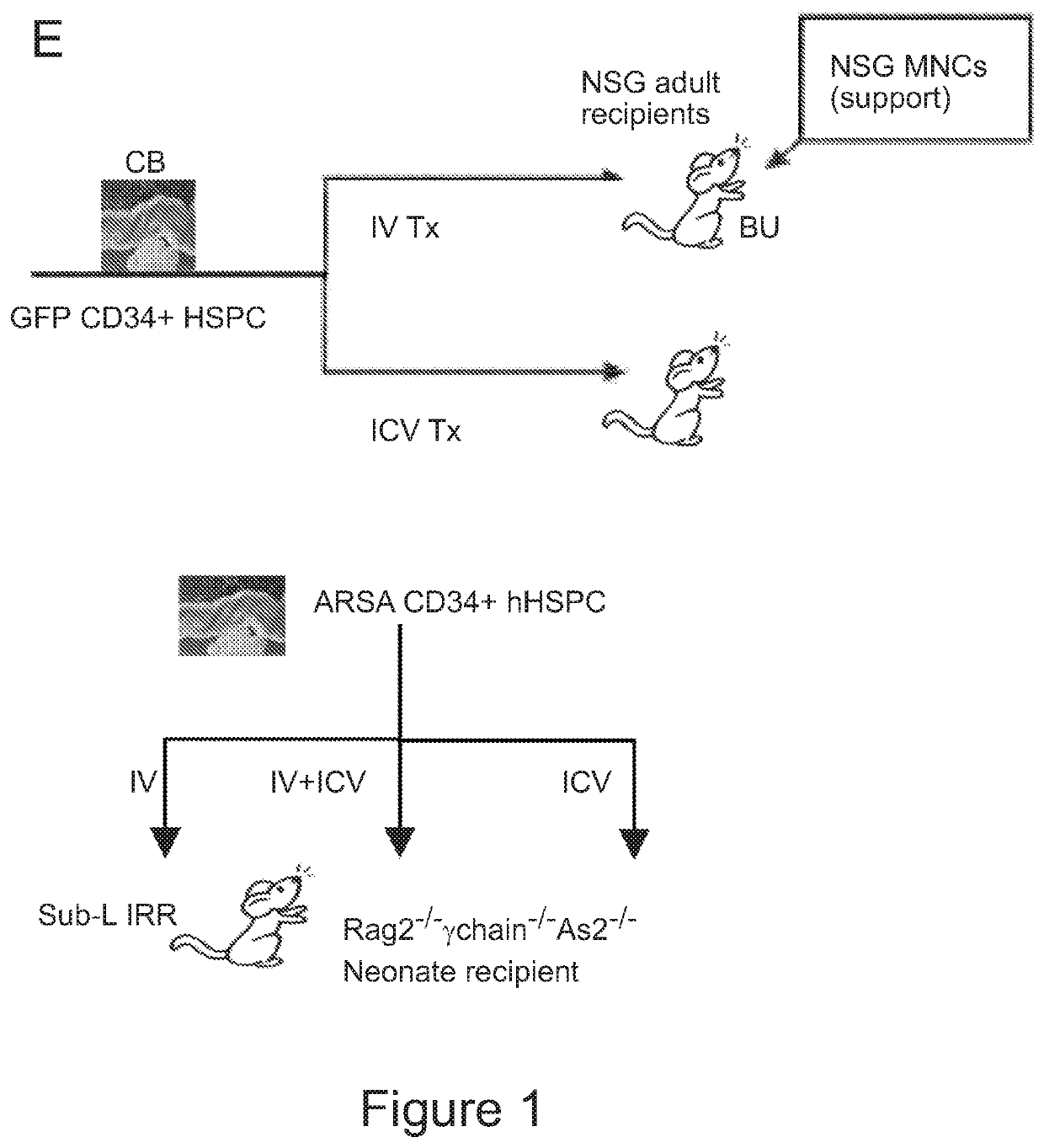Compositions and methods for treating diseases and disorders of the central nervous system
a central nervous system and disease technology, applied in the direction of drug compositions, viruses/bacteriophages, genetically modified cells, etc., can solve the problems of slow pace of replacement of resident cns tissue macrophages/histiocytes and microglia by transplanted cells, patient eventually succumbing to devastating diseases, and based on the improvement of rapidly progressing sd brain diseases
- Summary
- Abstract
- Description
- Claims
- Application Information
AI Technical Summary
Benefits of technology
Problems solved by technology
Method used
Image
Examples
example 1
ebral Ventricular Injection of Murine HSPCs Results in Rapid and Robust Myeloid Cell Engraftment in Brain
[0179]Recent results (Capotondo et al., PNAS 2012) propose that engraftment and persistent donor chimerism in the bone marrow hematopoietic niche might not be necessary for obtaining myeloid cell reconstitution in the brain following HCT. Based on these findings it was assessed whether myeloid and microglia-like cell reconstitution could occur upon direct transplantation of HSPCs into the cerebral ventricular space in conditioned mice. Murine lineage negative (Lin) HSPCs (3×105 cells) were labeled with GFP-encoding Lentiviral Vectors (LVs) and transplanted by ICV injection in mice after exposure to a myeloablative busulfan dose or lethal irradiation (FIG. 1A). Interestingly, transplantation resulted in a high and progressively increasing GFP chimerism in the CD45+CD11b+ brain myeloid compartment of the ICV-transplanted mice, conceivably derived from the local proliferation of the...
example 2
ebral Ventricular Injection of Human HSPCs Results in Rapid and Robust Myeloid Cell Engraftment in Brain
[0181]In order to gain insight into the clinical relevance of this phenomenon, the ability of human HSPCs to generate microglia-like cells upon ICV delivery in conditioned immune deficient animal models was tested. ICV or IV human CD34+ cells were isolated from cord blood, transduced with GFP-encoding LVs, and infused into NOD.Cg-PrkdcscidIl2rgtm1WjI / SzJ (NSG) mice (FIG. 1E). Moreover, in order to determine the actual role of ICV cell transplantation in augmenting the potential of the transplant to deliver therapeutic molecules to the brain, a newly generated mouse model, the Rag− / −γ-chain− / −As2− / , was employed that reproduces the lysosomal disease Metachromatic leukodystrophy (MLD) due to Arylsulfatase A (ARSA) deficiency in an immune-deficient background. These mice received human cord blood CD34+ cells transduced with an ARSA encoding LVs (Biffi et al., Science 341, 1233158 (20...
example 3
ted HSPCs Engraft and Expand in the Brain, while they do not Engraft in the Hematopoietic Organs
[0183]By short-term flow cytometry monitoring of the mice transplanted IV or ICV with GFP-labeled Lin− HSPCs the presence, persistence and moderate expansion of the ICV-delivered cells in the brain of the recipient animals was demonstrated (FIG. 2A). Conversely, only detected negligible amounts of GFP+ cells were detected in the bone marrow of the ICV transplanted mice (+ cells transiently up-regulated early hematopoietic markers (FIG. 2C) and, afterwards, the CD11b, CX3CR1 and CD115 microglia markers up to levels similar to the endogenous microglia (FIG. 2D). The GFP− CD45+ endogenous cells transiently and slightly down-regulated CD115, as a possible effect of the busulfan treatment (FIG. 2D).
PUM
| Property | Measurement | Unit |
|---|---|---|
| size | aaaaa | aaaaa |
| diameter | aaaaa | aaaaa |
| diameter | aaaaa | aaaaa |
Abstract
Description
Claims
Application Information
 Login to View More
Login to View More - R&D
- Intellectual Property
- Life Sciences
- Materials
- Tech Scout
- Unparalleled Data Quality
- Higher Quality Content
- 60% Fewer Hallucinations
Browse by: Latest US Patents, China's latest patents, Technical Efficacy Thesaurus, Application Domain, Technology Topic, Popular Technical Reports.
© 2025 PatSnap. All rights reserved.Legal|Privacy policy|Modern Slavery Act Transparency Statement|Sitemap|About US| Contact US: help@patsnap.com



